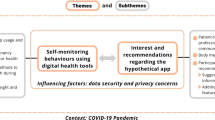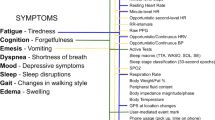Abstract
Objective:
The objective of this study is to evaluate the informative content of two free, pregnancy-specific smartphone applications and their accuracy and adherence to prenatal care guidelines.
Study Design:
This is a qualitative analysis of the information delivered through two free, pregnancy-specific smartphone applications (apps): Text4Baby (T4B) and Baby Center’s ‘My Pregnancy Today’ (BC). All information from conception through 2 weeks postpartum were transcribed and coded independently by two physician researchers. Content was analyzed and assigned thematic codes. The proportion of content each app delivered per theme was then calculated and the χ2-test was used to compare thematic frequency between apps.
Results:
A total of 609 pieces of daily content were transcribed; 698 message themes were coded and analyzed. Most information delivered by T4B was about fetal development (23.8%) or prenatal care (16.6%); most content from BC was about normal pregnancy symptoms (20.1%) or maternal well-being (21.1%); the differences between apps for each of these themes were statistically significant (P<0.05). A total of four messages contained incomplete or ambiguous content; neither app delivered overtly incorrect medical information. T4B and BC had a similar proportion of information that was in-line with the American College of Obstetrics and Gynecology Guidelines for Prenatal Care. Neither app delivered any messages about contraception.
Conclusion:
T4B and BC are free, pregnancy-specific apps with different focuses. Neither app delivers comprehensive prenatal information, as evidenced by the absence of information about postpartum contraception. More information is needed to determine the role of such apps in prenatal care.
This is a preview of subscription content, access via your institution
Access options
Subscribe to this journal
Receive 12 print issues and online access
$259.00 per year
only $21.58 per issue
Buy this article
- Purchase on Springer Link
- Instant access to full article PDF
Prices may be subject to local taxes which are calculated during checkout
Similar content being viewed by others
References
Pew Research Center. Mobile Technology Fact Sheet. Available at: http://www.fda.gov/downloads/MedicalDevices/DeviceRegulationandGuidance/GuidanceDocuments/UCM263366.pdf (accessed on 24 June 2015).
Azevedo R, Bernardes M, Fonseca J, Lima A . Smartphone application for rheumatoid arthritis self-management: cross-sectional study revealed the usefulness, willingness to use and patients’ needs. Rheumatol Int 2015; 35 (10): 1675–1685.
BinDhim NF, Shaman AM, Trevena L, Basyouni MH, Pont LG, Alhawassi TM . Depression screening via a smartphone app: cross-country user characteristics and feasibility. J Am Med Inform Assoc 2015; 22 (1): 29–34.
Case MA, Burwick HA, Volpp KG, Patel MS . Accuracy of smartphone applications and wearable devices for tracking physical activity data. JAMA 2015; 313 (6): 625–626.
Farag S, Chyjek K, Chen KT . Identification of iPhone and iPad applications for obstetrics and gynecology providers. Obstet Gynecol 2014; 124 (5): 941–945.
Whittaker R, Matoff-Stepp S, Meehan J, Kendrick J, Jordan E, Stange P et al. Text4baby: development and implementation of a national text messaging health information service. Am J Public Health 2012; 102 (12): 2207–2213.
About BabyCenter, L.L.C.|BabyCenterAvailable at http://www.babycenter.com/about (accessed on 24 June 2015).
American Academy of Pediatrics, American College of Obstetrics and Gynecology Guidelines for Perinatal Care, 8th edn. American Academy of Pediatrics: Washington, DC, 2013.
Mobile Medical Applications. Available at: http://www.fda.gov/medicaldevices/productsandmedicalprocedures/connectedhealth/mobilemedicalapplications/default.htm#a (accessed on 24 June 2015).
Lewkowitz AK, O'Donnell BE, Nakagawa S, Vargas JE, Zlatnik MG . Social media messaging in pregnancy: comparing content of Text4baby to content of free smart phone applications of pregnancy. J Matern Fetal Neonatal Med 2015; 29 (5): 745–751.
Robinson F, Jones C . Women’s engagement with mobile device applications in pregnancy and childbirth. Pract Midwife 2014; 17 (1): 23–25.
Kraschnewski JL, Chuang CH, Poole ES, Peyton T, Blubaugh I, Pauli J et al. Paging ‘Dr. Google’: Does technology fill the gap created by the prenatal care visit structure? qualitative focus group study with pregnant women. J Med Internet Res 2014; 16 (6): e147.
Tripp N, Hainey K, Liu A, Poulton A, Peek M, Kim J et al. An emerging model of maternity care: smartphone, midwife, doctor? Women Birth 2014; 27 (1): 64–67.
Android and iOS squeeze the competition, swelling to 96.3% of the smartphone operating system market for both 4Q14 and CY14, according to IDC - prUS25450615. Available at: http://www.idc.com/getdoc.jsp?containerId=prUS25450615 (accessed on 29 June 2015).
Evans WD, Wallace JL, Snider J . Pilot evaluation of the text4baby mobile health program. BMC Public Health 2012; 12: 1031.
Evans W, Nielsen PE, Szekely DR, Bihm JW, Murray EA, Snider J et al. Dose-response effects of the text4baby mobile health program: randomized controlled trial. JMIR Mhealth Uhealth 2015; 3 (1): e12.
Evans WD, Wallace Bihm J, Szekely D, Nielsen P, Murray E, Abroms L et al. Initial outcomes from a 4-week follow-up study of the Text4baby program in the military women's population: randomized controlled trial. J Med Internet Res 2014; 16 (5): e131.
Author information
Authors and Affiliations
Corresponding author
Ethics declarations
Competing interests
The authors declare no conflict of interest.
Rights and permissions
About this article
Cite this article
O'Donnell, B., Lewkowitz, A., Vargas, J. et al. Examining pregnancy-specific smartphone applications: what are patients being told?. J Perinatol 36, 802–807 (2016). https://doi.org/10.1038/jp.2016.77
Received:
Revised:
Accepted:
Published:
Issue Date:
DOI: https://doi.org/10.1038/jp.2016.77
This article is cited by
-
Safe sleep and reading guidance during prenatal care? findings from a pilot trial using specially designed children’s books
Journal of Perinatology (2022)
-
An ethical exploration of pregnancy related mHealth: does it deliver?
Medicine, Health Care and Philosophy (2021)
-
“A good little tool to get to know yourself a bit better”: a qualitative study on users’ experiences of app-supported menstrual tracking in Europe
BMC Public Health (2019)
-
Apps in der Inneren Medizin
Der Internist (2019)
-
Acceptance of a new non-invasive fetal monitoring system and attitude for telemedicine approaches in obstetrics: a case–control study
Archives of Gynecology and Obstetrics (2018)



